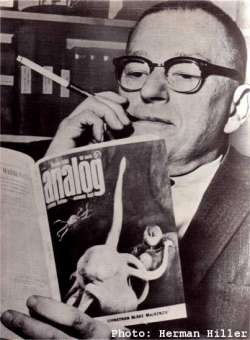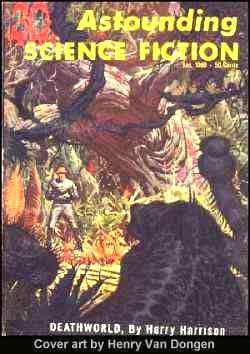 John Wood Campbell, Jr. may not have been science fiction's great
pioneer - an honour reserved for Hugo Gernsback - but he was responsible
for shaping modern science fiction and taking it from its pulp adventure
beginnings to stories where science provided more than simply a backdrop or
an excuse for more and bigger spaceships and weapons.
John Wood Campbell, Jr. may not have been science fiction's great
pioneer - an honour reserved for Hugo Gernsback - but he was responsible
for shaping modern science fiction and taking it from its pulp adventure
beginnings to stories where science provided more than simply a backdrop or
an excuse for more and bigger spaceships and weapons.Educated at MIT and Duke University, where he obtained a degree in Physics in 1932, Campbell published his first story while still an undergraduate in 1930. By the middle of the Depression he was writing a series of stories for the pulps, focussing on heroes working together to create 'super-science' inventions which the human race would need to survive. These were 'star-smashing' adventures to rival those of E.E. 'Doc' Smith, but were to mark only the first stage in his writing career.
In November 1934 Campbell published the story "Twilight," under the name Don A. Stuart, the first to show a greater philosophical depth and a more 'literary' style. Both factors were encouraged in the writing of others when Campbell took over as editor of Astounding. Perhaps Campbell's best-known story, again published under the Stuart name, is "Who Goes There?" which wads published in 1938, and has been filmed twice as The Thing directed by Christian Nyby in 1951 and John Carpenter in 1982.
 In September 1937 Campbell took over as editor of Astounding, and
presided over what has come to be known as science fiction's Golden Age.
Campbell's view was that human survival requires strong individuals who
have the ability of co-operation and also intellectual adaptability, more
specifically the ability to embrace modern science, and it must be
humanised by enfolding it in good storytelling. After he became editor of
Astounding, Campbell wrote fewer stories, preferring instead to
'collaborate' with his authors. His detailed and extensive correspondence
with writers resulted in the creation of Isaac Asimov's Laws of Robotics
and Harry Harrison's Deathworld trilogy, as well as a great deal of
classic SF. Asimov, Lester del Rey, and Robert Heinlein were Campbell
'discoveries' and he encouraged the SF writing of Theodore Sturgeon and A.E
van Vogt. While established writers such as Jack Williamson, Clifford D.
Simak, L. Sprague de Camp and L. Ron Hubbard were also adopted into his
'stable.'
In September 1937 Campbell took over as editor of Astounding, and
presided over what has come to be known as science fiction's Golden Age.
Campbell's view was that human survival requires strong individuals who
have the ability of co-operation and also intellectual adaptability, more
specifically the ability to embrace modern science, and it must be
humanised by enfolding it in good storytelling. After he became editor of
Astounding, Campbell wrote fewer stories, preferring instead to
'collaborate' with his authors. His detailed and extensive correspondence
with writers resulted in the creation of Isaac Asimov's Laws of Robotics
and Harry Harrison's Deathworld trilogy, as well as a great deal of
classic SF. Asimov, Lester del Rey, and Robert Heinlein were Campbell
'discoveries' and he encouraged the SF writing of Theodore Sturgeon and A.E
van Vogt. While established writers such as Jack Williamson, Clifford D.
Simak, L. Sprague de Camp and L. Ron Hubbard were also adopted into his
'stable.'
In 1939 Campbell created a new magazine, Unknown, a fantasy magazine which featured the work of L. Sprague de Camp (including Lest Darkness Fall), Fletcher Pratt, Anthony Boucher, L. Ron Hubbard, Fritz Leiber (the Fafhrd-Gray Mouser stories), Robert Heinlein and Alfred Bester. The magazine is regarded as one of the most important of its type, and publication ended in 1943 as a result of wartime paper shortages.
Campbell was editor of Analog magazine until his death in July 1971. After his death, Harry Harrison was instrumental in putting together an anthology as a tribute to Campbell - Astounding: The John W. Campbell Memorial Anthology and in establishing an award, the John W. Campbell Memorial Award.